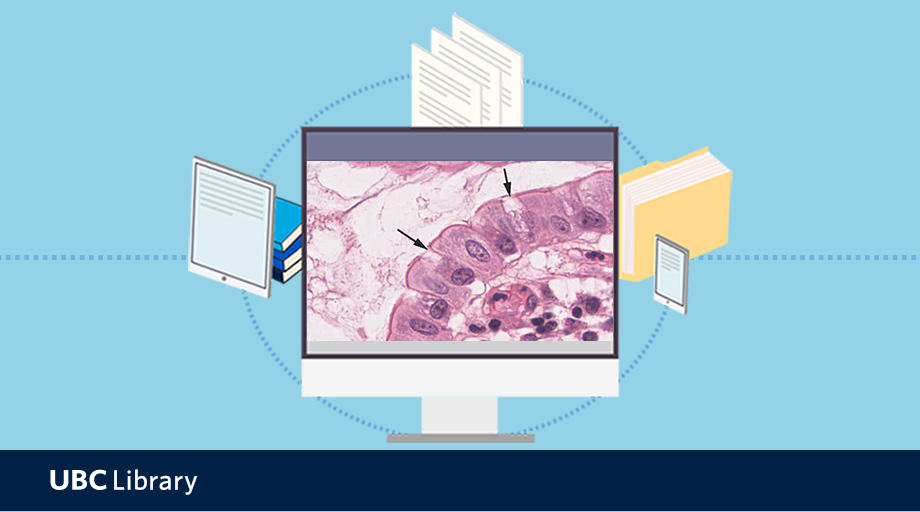
Are you a budding pathologist who is curious to see what human disease looks like up close? A new multimedia resource that delves into the science behind disease is now available to health science students, faculty and the general public through UBC Library’s open textbook catalogue. The open text is a result of a collaboration between UBC and the British Columbia Institute of Technology (BCIT), led by coauthors Dr. Jennifer Kong and Helen Dyck.
Kong holds a dual appointment as the acting manager of the UBC David F. Hardwick Pathology Learning Centre (DHPLC) in Vancouver, and as faculty with Department of Basic Health Sciences at BCIT in Burnaby. Helen Dyck was the DHPLC manager (currently on leave). Together, they collaborated on Pathology: From the Tissue Level to Clinical Manifestations and Inter-professional Care. With funding awarded through the BCIT Open Education Grant and UBC OER Rapid Innovation Grant, Kong and Dyck developed the first three chapters of the open text with the help of undergraduate student Lyz Boyd from the Faculty of Medicine.
While Pathology was created with undergraduate health science students in mind, it’s written in an accessible format, as a beginner’s guide to disease with descriptions for each video, interactive exercises, and an extensive glossary. The text is structured as a highly visual guide to a selection of common diseases like melanoma, cirrhosis and emphysema, using videos and photos of specimens and histology slides to show disease presentation and progression. All the specimens and slides included in the text are from DHPLC’s specialized collections.
While the inclusion of video content and interactive elements make this text such a valuable learning tool, it also made the publication process more complicated.
“It was a massive learning curve on my part,” says Kong, speaking candidly about the process of creating a multimedia resource. Initially hesitant about tackling the more technical aspects of the project, Kong says that working with Erin Fields, Open Education and Scholarly Communications Librarian at UBC Library, made it possible.
“I thought I had to do it on my own,” says Kong. “I think it’s because, as researchers, we always have to do things on our own. You can’t share [your project] with anybody else because you don’t want to get scooped. But this is different because I get to focus on my content, and the library is there to support me with everything else.”
“I always say to faculty, ‘You are focusing on the content because you’re an expert in the content.’ And the library team are experts in how to turn that content into a text” adds Fields.
In turn, Fields notes that Pathology is the biggest and most fulsome open text project that she’s worked on so far, because the textbook makes use of several advanced features: interactive quizzes, anatomy labelling exercises, embedded videos, and even a printable, “flat version” of the text.
“We were able to prove that we could do a multimedia resource,” says Kong, and with that proof, she and Dyck were able to apply for additional funding, through the UBC OER Implementation Grant, UBC Okanagan Provost’s Office and the Irving. K. Barber Faculty of Science, to expand the resource into further chapters.
The new funding also allowed Kong to hire students, who not only helped edit the first three chapters, but were excited to contribute to the writing process and develop video content. “That’s why we have several student authors for each chapter, who now also have something to add to their curriculum vitae and applications,” notes Kong.
The need for open educational resources (OER) at UBC has been steadily increasing since UBC Library started offering support for open textbook publishing in 2019. Fields and her colleagues help UBC faculty and instructors navigate copyright standards, Creative Commons licensing, metadata, and technical support using Pressbooks. The library’s catalogue has grown substantially over the last four years to include 24 open texts that range in subject matter from geography to social psychology.
However, Pathology signals a new wave of medical-related open textbook projects, as Fields notes that the library is receiving an increasing number of requests to support OERs in fields such as nursing, pediatric dermatology, and climate change on health.
“Nursing and medical departments are starting to build open education resources. I always thought that that wasn’t going to happen for fear of content being taken and misused, but I think in the wave of so much misinformation that is already happening, this is a way for people to say that this is the accurate information that needs to get out there,” says Fields. “This is what knowledge exchange looks like for our research team. It has been really exciting to see faculty in medicine getting excited about open access resources, where I think medicine has always been cautious about the idea.”
About the UBC Library Open Publishing Program
UBC Library’s Open Publishing Program is an open access journal and text service to help UBC faculty, researchers, instructors, students, and staff develop open access publications for scholarship and instruction. This free service aims to advance open scholarship by providing the supports needed to make UBC information resources openly available. Learn more about our eligibility criteria and how to submit a proposal.